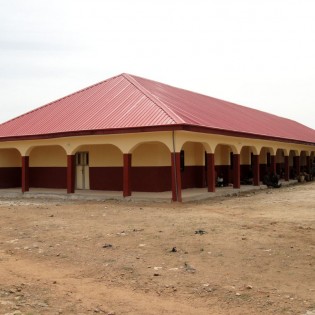As from 1950 until her retirement in 1973 Dr.Priestman, a British leprosy doctor,ran a leprosy centre in Mangu in Central-Nigeria. In those days for many it was a lifelong treatment .
 In 1974 dr. Cees Spronk, then a leprosy doctor, took over the management, supported by the Netherlands Leprosy Relief Association.The treatment of leprosy developed enormously and had tobe integrated in the general health care. Partly because of this the choice was made for a rehabilitation centre for leprosy patients, poliopatients and patients with other physical handicaps with the emphasis on the treatment of children.
In 1974 dr. Cees Spronk, then a leprosy doctor, took over the management, supported by the Netherlands Leprosy Relief Association.The treatment of leprosy developed enormously and had tobe integrated in the general health care. Partly because of this the choice was made for a rehabilitation centre for leprosy patients, poliopatients and patients with other physical handicaps with the emphasis on the treatment of children.
The operation theatres were modernised for the performance of corrective surgery. For non-leprosy patients a new ward with 32 beds was built and a new building was constructed for the pharmacy department, the outpatient clinic and the administration. Physiotherapy was also housed in a new building.
In 1980, the final year that Cees Spronk worked in Mangu, the entire project was finished after which the new centre was opened festively and was named the “COCIN Hospital and Rehabilitation Centre”, COCIN meaning Church of Christ in Nigeria.
From January 1983 until March 1987 dr. Arend van de Veniswas in charge of the hospital. In those days he did much for the development of ophthalmology. In about ten years’ time the centre developed more and more into a general hospital.
In 2004 dr. Spronk, dr. van de Venis and their wives visited the COCIN hospital in Mangu. It functioned well but it was obvious that the budget was very limited.
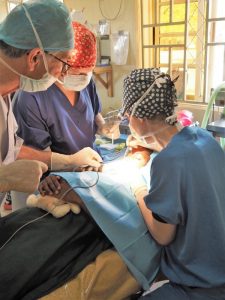 From 2007, with supportof the Interplast Holland Foundation, a programme was started in which twice a year a plastic surgery team visited the hospital. During the first mission few patients turned up. The operations are free of charge, but the hospital expenses had to be paid, for which the patients had no money.
From 2007, with supportof the Interplast Holland Foundation, a programme was started in which twice a year a plastic surgery team visited the hospital. During the first mission few patients turned up. The operations are free of charge, but the hospital expenses had to be paid, for which the patients had no money.
Then the Faridpur Foundation decided to grant each patient 50 euros, resulting in a larger number of patients.Many deformities were operated upon, especially children with burns and consequent deformities, many congenital abnormalities such as schisms, hand-deformities and clubfeet.
In fact there were too few beds and the operation theatre was too small and did not meet the present-day requirements. The Faridpur Foundation decided to tackle this problem as well, which was imbedded in a programme for the improvement of burn care.
In 2011 a new pavilion with 50 beds was opened, so that patients no longer had to sleep on mattresses on the floor after their operation.
For this we received financial aid from Church in Action and the necessities such as beds were donated by the Dutch Embassy.
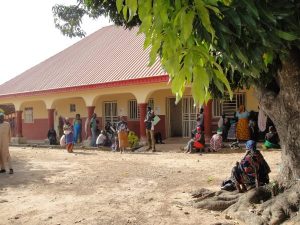 In 2012 a new operation complex was built with two operation theatres, a plaster room and a recovery room.Building the complex was financed by the Dutch initiative “Slag om e Mar”.The equipment was mainly financed by Rotary Harlingen. The old operation theatre was changed into a nursing unit for patients with severe burns.
In 2012 a new operation complex was built with two operation theatres, a plaster room and a recovery room.Building the complex was financed by the Dutch initiative “Slag om e Mar”.The equipment was mainly financed by Rotary Harlingen. The old operation theatre was changed into a nursing unit for patients with severe burns.
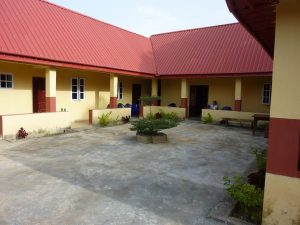 In 2015 a new guesthouse was built, because the teams became bigger and the old guesthouse (an oud missionary house) with one toilet and one bathroom was too small.
In 2015 a new guesthouse was built, because the teams became bigger and the old guesthouse (an oud missionary house) with one toilet and one bathroom was too small.
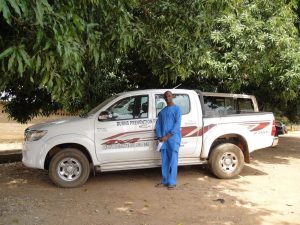 In 2016 the burn-programme started after KefasTuwan and Dr.Kuden had taken a course on prevention and treatment of burns in Uganda given by Dr. Rein Zeeman. For thispurposea Toyota Hilux was bought to give educationin a wide area around Mangu.
In 2016 the burn-programme started after KefasTuwan and Dr.Kuden had taken a course on prevention and treatment of burns in Uganda given by Dr. Rein Zeeman. For thispurposea Toyota Hilux was bought to give educationin a wide area around Mangu.
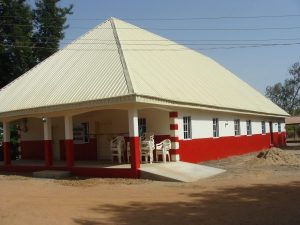 Finally, in 2018 a new laboratory was opened, financed by Medical Beneficiary Friesland, an initiative of the co-assistants of the Frisian hospitals.
Finally, in 2018 a new laboratory was opened, financed by Medical Beneficiary Friesland, an initiative of the co-assistants of the Frisian hospitals.
For 2019 we try to finance the maintenance and extension of the outpatientsclinic, a forty-year-old building which has become too smalland needs maintenance.
Electricity in Nigeria is abominable and the hospital depends on a generator which is very old and needs to be replaced.
In short, the COCIN Hospital and Rehabilitation Centre is a general hospital in an area with religious conflicts whereeveryone who goes there will receive treatment irrespective of religion. Half of the patients are Muslims.
The hospital offers special care for:
- Ophthalmology, with many cataractoperations
- Orthopaedics and rehabilitation
- Leprosy and tuberculosis treatments
- HIV prevention and treatment
- Maternity and child care
- Treatment of burns and reconstructive surgery (with our aid and that of Interplast Holland)
The income of the hospital almostsolelycomes from what patients pay. Taken the poverty in this area in account the rates must not be too high. Otherwise care will become unaffordable. The salaries are always in arrears and there is no money for maintenance. Many ngo’sthat supported in the past, such as the leprosy funds, the Christian Blind Mission and an American organization that fights HIV no longer contribute, leaving patients out in the cold, which means that all the support we can give is necessary and very welcome!


